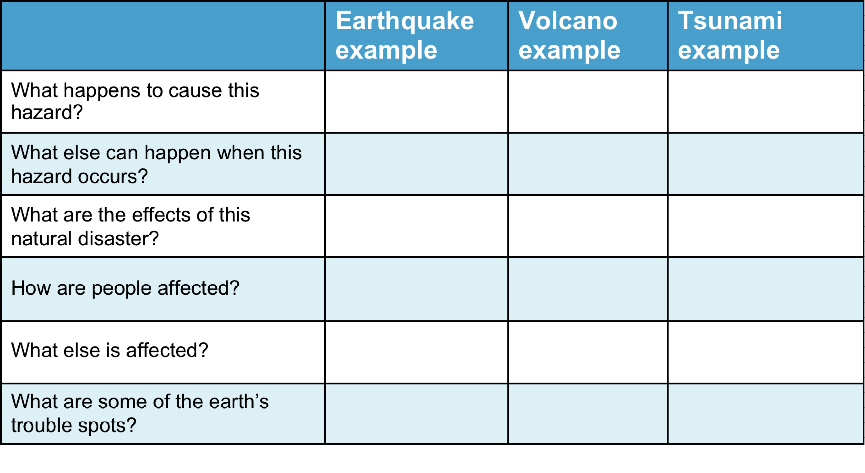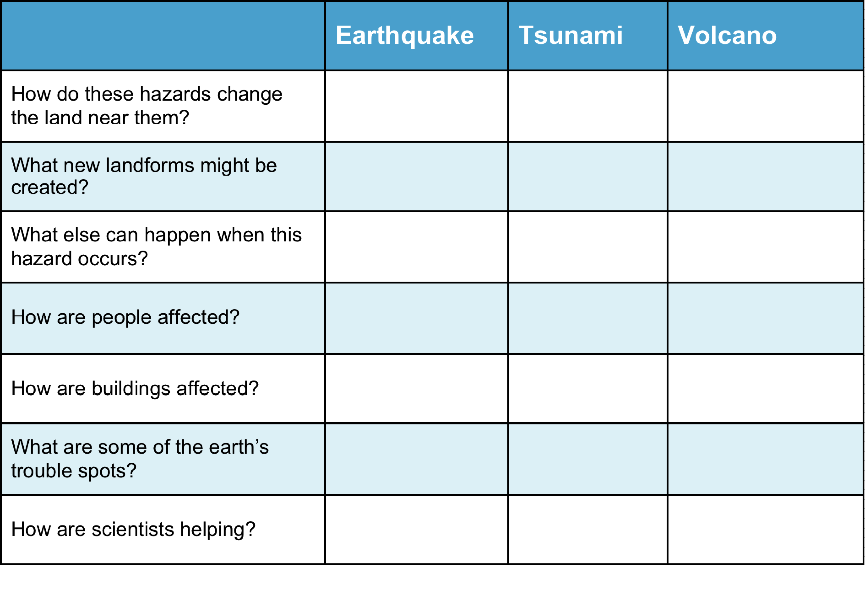Information for Teachers
Curriculum links
Australian Science Standards
ESS (ACSSU075) Earth’s surface changes over time as a result of natural process and human activity
ESS (ACSSU075) Rocks and fossils show evidence of changes in Earth’s surface features
ESS (ACSSU075) Natural processes create changed or different landforms
New Zealand Science Achievement Objectives
PEB: The composition structures and features of the geosphere, hydrosphere and atmosphere
PW: The effect of forces (contact and non-contact) on the motion of objects
Helpful websites
You may want to direct your students to websites to help with their investigations.
Students may want to learn more about one type of moving earth hazard. They can do a search for the name of the moving earth hazard (e.g. earthquake)+trouble+spots or earthquake+hotspots. They can search each moving earth hazard this way.
Or they may want to learn more about the effects of this hazard by searching earthquake+effects.
Other search topics could be volcanoes+affect+people
How to search the internet
1 Keep your request short
Fewer words will give a more accurate search.
2 Choose exactly what you want
For example: Arctic Circle Climate
3 Use quotes
Double quotes around a set of words tell the search engine to consider those exact words in that exact order without any change. For example: “Arctic Circle Climate”
4 Use the plus sign (+)
If you add a plus sign (+) between words, the internet will search for all the words. For example: migrate+birds+whales+mammal
5 Use the minus sign (–) to say what you don’t want
Use a minus sign (–) to show words you do not want to appear in your results. For example: if you search for burrowing animals and do not want mammals in your search, –mammals will exclude mammals. Note that you need to put a space before the minus sign for the word to be excluded.
6 Be very clear about what you don’t want
Part 1
Ask questions and make predictions
After reading Our Moving Earth, you may have many questions about how our earth moves and what happens when it moves.
List your questions.
- Compare your list with questions that others have.
- Choose a question you would like to investigate.
- You can work alone, with a partner, or in a small group.
You may want to choose one or more of these questions to investigate
Q1. What makes up the inner structure of the earth?
Q2. How does the rock in the earth’s crust move?
Q3. What happens when the earth’s crust changes?
Q4. How are scientists trying to predict natural hazards caused by the earth’s movements?
Go to Part 2 Plan and investigate →Part 2
Plan and investigate
Do searches in the internet or in books or talk to people who can help to find the information you are looking for.
Your teacher may suggest suitable websites for further information.
Go to Part 3 Record and analyse data →Part 3
Record and analyse data
Find a way of recording your information that will allow you to see any patterns in the data.
Data Chart for Our Moving Earth
 Download Chart
Download Chart
Go to Part 4 Evaluate the information →
Part 4
Evaluate the information
1. Look over the information you have gathered and the patterns you have found.
How is the earth’s crust constantly changing? Why is this so?
2. Search for other patterns.
What are the most destructive natural hazards caused by the moving earth?
How is the landscape changed?
3. Makes notes about what you find.
Go to Part 5 Communicate and share ideas →Part 5
Communicate and share ideas
Look over all of the information that you have gathered in your investigation.
What are the most important ideas about the moving earth?
Make a chart showing the most important ideas.
 Download Chart
Download Chart
← Return to menu
